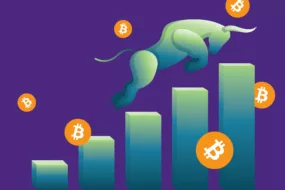
Perpetual Protocol (PERP) is a decentralized trading platform that allows users to trade perpetual swaps securely, quickly, and cost-effectively.
Built on the Ethereum blockchain, PERP leverages the power of decentralized finance (DeFi) to offer traders access to a range of assets, including cryptocurrencies and traditional financial instruments.
With low trading fees, fast settlement times, and a non-custodial design that puts users in control of their assets, Perpetual Protocol is redefining how traders access and interact with derivative products.
In this article, we will take a closer look at the key features of Perpetual Protocol, its use cases, and limitations providing you with an overview of this exciting decentralized trading platform.
What is Perpetual Protocol (PREP)?
Perpetual Protocol (PERP) is a decentralized perpetual contract trading platform built on the Ethereum blockchain.
So what is a perpetual contract?
Perpetual contracts are derivative contracts that allow traders to take long or short positions on an asset ‘without an expiry date.’ It means they can hold their positions indefinitely.
A derivative contract is a financial agreement between two parties that derives its value from an underlying asset, such as stocks, bonds, or commodities. The value of the contract is based on the price movements of the underlying asset. The agreement implies buying or selling the underlying asset at a future date (expiry date) at a pre-determined price and quantity.
But, as mentioned, in the case of perpetual contracts, there is no expiry date. Thus, the contract can be held indefinitely and does not require the buyer or seller to settle at a specific time.
Perpetual contracts are commonly used in cryptocurrency trading and are often used for long-term trading strategies and for hedging against market risks.
Now coming back to the perpetual protocol, it aims to provide a decentralized and transparent platform for perpetual contract trading, with low fees, high liquidity, and a user-friendly interface.
PERP is the native token of the Perpetual Protocol platform. It is used for various functions within the platform, such as paying trading fees, providing liquidity to the protocol, and participating in governance. Holders of PERP can also earn rewards for staking their tokens.
History of Perpetual Protocol
The idea for Perpetual Protocol originated in early 2020 when a team of developers and entrepreneurs built a decentralized exchange (DEX) that offered perpetual contracts.
The team saw an opportunity to create a platform that offered a better user experience and lower fees than existing DEXs. They also wanted to create a fully decentralized platform, meaning users would have full control over their funds and trades.
The Perpetual Protocol team started building the platform in mid-2020 and launched the first version of the platform on the Ethereum network in December 2020.
Since its launch, Perpetual Protocol has seen significant growth in trading volume and user adoption.
The team behind Perpetual Protocol continues to work on improving the platform and adding new features, such as support for layer two solutions and additional trading pairs.
Working Mechanism
Perpetual protocol was built on Ethereum and used an automated market maker (AMM) model for liquidity provision. Users could trade perpetual contracts without a centralized order book or market maker.
The Perpetual Protocol uses an automated market maker (AMM) model to provide liquidity. The AMM model used by Perpetual Protocol is based on a virtual automated market maker (vAMM) that is designed to provide more efficient price discovery and lower slippage than traditional AMMs. The vAMM is a smart contract that algorithmically sets the price of a perpetual contract based on supply and demand.
When users want to trade on Perpetual Protocol, they must first deposit their funds into a smart contract that acts as a collateral pool. This collateral pool supports the perpetual contracts and ensures sufficient liquidity is always available for traders.
Once the user has deposited their funds into the collateral pool, they can trade perpetual contracts with other users on the platform. As mentioned, the price of the perpetual contract is determined by the vAMM. When a trade is executed, the vAMM automatically adjusts the contract’s price to ensure sufficient liquidity is always available.
The trading fees on Perpetual Protocol are paid in the platform’s native token, PERP. The fees are used to incentivize liquidity providers on the platform. Users can also earn additional rewards by staking PERP tokens, which are used to govern the platform and make important decisions regarding its development.
Use Cases
Perpetual Protocol has several potential use cases, including,
1. Trading
The primary use case of Perpetual Protocol is for trading perpetual swaps.
Traders can use the platform to speculate on the price movements of various assets, including cryptocurrencies and traditional financial instruments.
2. Hedging
Perpetual swaps can also be used as a hedging tool to protect against price fluctuations in the underlying asset.
For example, a cryptocurrency miner could use Perpetual Protocol to hedge against price drops in their mined cryptocurrency.
3. Liquidity Provision
Traders can also provide liquidity to the platform by depositing assets into the liquidity pool. In return, they earn trading fees and a share of the platform’s revenue.
4. Yield Farming
Perpetual Protocol offers yield farming opportunities, where users can earn additional rewards by staking their assets on the platform.
Key Features
Some of the key features of Perpetual Protocol include,
1. Decentralized
Perpetual Protocol is built on the Ethereum blockchain and is fully decentralized. Thus, no central authority controls the platform.
2. Non-custodial
Traders always retain control of their assets, as Perpetual Protocol uses a non-custodial design. It allows users to trade without depositing their assets into a centralized exchange.
3. Low Fees and Fast Settlement
Perpetual Protocol charges low trading fees of 0.1% or less, making it an affordable option for traders of all sizes.
Also, trades on Perpetual Protocol settle in seconds, thanks to the platform’s automated market maker (AMM) design.
4. Capital Efficiency
Perpetual Protocol uses a virtual automated market maker (vAMM) design that enables traders to leverage their positions by up to 10x, which can increase capital efficiency.
Limitations
While Perpetual Protocol offers several benefits, there are also some limitations to the platform,
1. High Risk
Perpetual swaps are high-risk derivative products that are not suitable for all traders.
Due to their leveraged nature, traders can quickly lose more than their initial investment if the market moves against them.
2. Limited Liquidity
As a relatively new platform, Perpetual Protocol may have limited liquidity compared to more established centralized exchanges. Thus, it could impact trading volumes and execution prices.
3. Vulnerability to Smart Contract Risks
Like all decentralized platforms, Perpetual Protocol is vulnerable to smart contract risks, such as coding bugs, which could lead to financial losses for traders.
Conclusion
Perpetual Protocol (PERP) is a promising decentralized trading platform that has the potential to revolutionize the way traders access and interact with perpetual swaps.
With its low trading fees, fast settlement times, and non-custodial design, PERP provides users a secure, transparent, and efficient way to trade derivatives. While there are limitations and risks associated with using decentralized platforms, Perpetual Protocol’s commitment to innovation, expansion, and community building suggests a bright future for the platform.
As the decentralized finance ecosystem continues to evolve, Perpetual Protocol is well-positioned to become a leading player in the rapidly growing space of decentralized trading.
FAQs
1. What is Perpetual Protocol, and how does it differ from traditional trading platforms?
Perpetual Protocol is a decentralized trading platform that enables users to trade perpetual contracts. These are derivative contracts that mimic futures contracts’ behavior but do not expire.
Unlike traditional trading platforms, Perpetual Protocol is built on a decentralized infrastructure. This results in a more transparent and censorship-resistant platform.
2. What are the benefits of using Perpetual Protocol for derivatives trading?
Perpetual Protocol offers several benefits for derivatives trading, including 24/7 trading availability, low transaction fees, and the ability to trade with high leverage. The platform also offers a wide range of trading pairs and allows users to create custom ones.
Also, because the platform is decentralized, users maintain control over their funds and can trade without intermediaries.
3. How can users participate in liquidity pools on Perpetual Protocol?
Users can participate in liquidity pools on Perpetual Protocol by depositing assets into the pool and receiving liquidity pool tokens in exchange. These tokens represent the user’s pool share and can be used to earn trading fees and rewards.
The platform uses an automated market maker (AMM) algorithm to determine the prices of assets in the pool, ensuring that trades can be executed without needing an order book.





